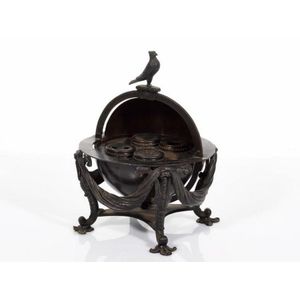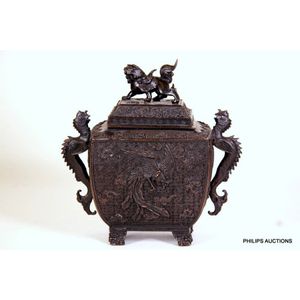Japanese Bronze Koro with Sea Creature Handles and Relief Motifs
A Japanese bronze Koro, a square section tapering base and a stepped conforming lid with a lion finial, fantastic spiny backed and finned sea creature handles, the body with phoenix, dragon and scrolling motifs in relief upon a diaper ground, raised on mask feet; bordered seal mark in relief underside, height 21 cm, width 21 cm
You must be a subscriber, and be logged in to view price and dealer details.
Subscribe Now to view actual auction price for this item
When you subscribe, you have the option of setting the currency in which to display prices to $Au, $US, $NZ or Stg.
This item has been sold, and the description, image and price are for reference purposes only.
- Bronze - An alloy of copper and tin, traditionally in the proportions of about 9 parts of copper to 1 part of tin.
The discovery of bronze in Western Asia in the 4th century enabled people to create metal objects which were superior to those previoulsy possible because of its strength and hardness, and it has been used throughout the world for weapons, coins, tools, statuary and other decorative items.
It is very fluid in a molten state, and its hardness, strength when set, and non-corrosive properties makes it most suitable for casting sculpture. - Finial - An architectural decoration, found on the upper parts of of an object. On furniture they are usually found on pediments, canopies and shelf supports. On smaller ceramic or silver items, such as spoons, they may decorate the top of the item itself, or the lid or cover where they provide a useful handle for removal.
Finials have a variety of shapes and forms. They may be urn-shaped, baluster shaped round or spiral, but usually taper into an upper point. Many real life shapes may also be used as finials, such as pineapples, berries, pinecones, buds, lotus and acorns. Sometimes animals such as a lion are depicted, or fish and dolphins. - Diaper Motif - The diaper motif is a repeating geometric pattern in decorative arts that consists of small diamond or lozenge shapes arranged in a grid. The pattern is often used as a background or border on textiles, ceramics, metalwork, and other decorative items. It can be found in a variety of cultures and historical periods, and is often used in formal or ornamental designs. The name "diaper" comes from the pattern's resemblance to the criss-crossed fabric of a baby's diaper.
This item has been included into following indexes:
- oriental objects
Visually similar items

Japanese bronze Koro, Meiji period with crane finial, Japanese character signed to underside, height 38 cm. Provenance: Property of a Lady, NSW
Sold by
in
for
You can display prices in $Au, $US, $NZ or Stg.

A 19th century bronze censer on caryatid feet, the cover with a cupid
Sold by
in
for
You can display prices in $Au, $US, $NZ or Stg.

A large Thai figure of Buddha, in a seated pose, with a serene gaze.
Sold by
in
for
You can display prices in $Au, $US, $NZ or Stg.

Bronze globe inkstand, 19th century, surmounted by an eagle, with glass inkbottles. Height 29 cm
Sold by
in
for
You can display prices in $Au, $US, $NZ or Stg.
